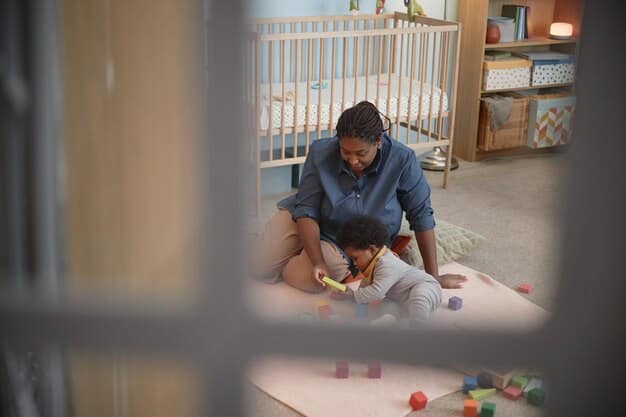Childcare for Infants: Expert Advice for US Parents Returning to Work in 2025

Childcare for infants is a critical consideration for US parents returning to work in 2025, requiring careful planning and evaluation of options like daycare centers, in-home nannies, and family support to ensure a smooth transition and the well-being of their child.
Returning to work after having a baby is a significant transition for any parent. For US parents in 2025, securing reliable and nurturing childcare for infants is paramount. This article provides expert advice to help navigate the options and make informed decisions.
Understanding the Childcare Landscape in the US
Choosing the right childcare option is a deeply personal decision. Understanding the current landscape in the US is the first step. Let’s explore the available options and their associated costs.
The US childcare system is a patchwork of different providers, regulations, and funding models. This can make it challenging for parents to navigate, especially when considering childcare for infants.
Types of Childcare Available
Several childcare options are available for infants in the US, each with its own benefits and drawbacks.
- Daycare Centers: These centers offer structured care for groups of children, often with age-appropriate activities and trained staff.
- In-Home Nannies: Nannies provide personalized care in the child’s home, offering flexibility and individual attention.
- Family Childcare Homes: These are smaller childcare settings run by individuals in their homes, offering a more intimate environment.
- Family Support: Relying on family members, such as grandparents, for childcare can be a cost-effective and familiar option.
The Cost of Childcare
The cost of childcare for infants can vary significantly depending on location, type of care, and the provider’s qualifications.
According to recent studies, the average cost of center-based infant care in the US ranges from $10,000 to over $20,000 per year. Nannies typically cost more, reflecting the personalized attention and flexibility they offer.
In conclusion, understanding the various childcare options and the associated costs is essential to make an informed decision. Don’t overlook the importance of your budget, but also consider what’s best for your baby.
Assessing Your Family’s Needs
Before diving into specific childcare for infants options, it’s crucial to assess your family’s unique needs and priorities. What works for one family may not work for another. Let’s determine your childcare requirements.
Consider factors such as your work schedule, budget, parenting style, and your child’s temperament. This will help you narrow down your choices and find a care arrangement that aligns with your family’s values.

Work Schedule and Location
Your work schedule and location will heavily influence your childcare options. Do you need full-time or part-time care? Do you need care during specific hours or days?
If both parents work full-time, a full-time daycare center or nanny may be the most suitable option. If one parent works part-time or from home, a part-time arrangement with a family childcare home or a babysitter could be a better fit.
Budget Considerations
Childcare can be a significant expense, so it’s important to factor it into your family’s budget. Explore your financial limitations before committing to an option.
Consider the long-term costs, including transportation, meals, and potential sick days. Don’t hesitate to research financial support programs and tax credits that may be available to help offset the cost of childcare for infants.
By carefully assessing your family’s needs and priorities, you’ll be better equipped to make a thoughtful decision about childcare for infants. There is no right or wrong answer necessarily; it all depends on unique factors.
Evaluating Childcare Options
Once you have a clear understanding of your family’s needs, start the process of evaluating different childcare for infants options. This involves researching providers, visiting facilities, and asking the right questions.
Don’t be afraid to be picky. This is your child’s environment, and it’s extremely important to choose wisely.
Researching Providers
Use online resources, referrals from friends and family, and local childcare agencies to identify potential providers.
- Online Reviews: Check online reviews and ratings to get an idea of other parents’ experiences with the provider.
- Referrals: Ask friends, family, and coworkers for referrals to reputable providers.
- Accreditation: Look for providers that are accredited by national organizations, such as the National Association for the Education of Young Children (NAEYC).
Visiting Facilities
Schedule visits to potential daycare centers and family childcare homes to observe the environment and interact with staff.
Pay attention to the cleanliness, safety, and organization of the facility. Observe how the staff interacts with the children and ask about their qualifications and experience.
Asking the Right Questions
Prepare a list of questions to ask potential childcare for infants providers. These questions should cover topics such as:
- Staff-to-child ratio: What is the staff-to-child ratio for infants?
- Curriculum: What type of curriculum or activities do you offer for infants?
- Safety policies: What are your safety policies and procedures?
- Emergency procedures: What are your emergency procedures?
Evaluating your childcare options is an essential step to make sure that your children are in a loving and safe environment while you are away.
Preparing Your Infant for Childcare
Adjusting to childcare for infants can be a big change for young children. Help to gradually prepare your infant for this transition.
Starting early with some smart planning can alleviate stress that can be caused by separation. This way, both you and your child can enjoy a much smoother transition
Gradual Introduction
If possible, start with a gradual introduction to the childcare for infants setting. This could involve spending a few hours each day at the facility before transitioning to full-time care.
This allows your infant to get used to the new environment and caregivers gradually, reducing anxiety and stress.
Familiar Items
Send familiar items with your infant to the childcare for infants setting, such as a favorite blanket, toy, or pacifier.

These items can provide comfort and security, helping your infant feel more at ease in the new environment.
Establish a Routine
Establish a consistent routine at home, including feeding, naps, and playtime. This will help your infant feel more secure and predictable.
Share this routine with the childcare provider so they can maintain consistency during the day.
Preparing your infant for childcare requires taking steps to decrease any anxiety or stress. Your baby will be more comfortable knowing that you have established routines and familiarity during this time.
Navigating the Return to Work
Returning to work after having a baby can be an emotional time. Finding the right childcare for infants can ease this process.
It’s common to feel overwhelmed by your desire to provide for for your family and also make sure that your child is in good hands and taken care of.
Communicate with your employer
Communicate with your employer about your return-to-work plans, including your childcare arrangements and any flexible work options you may need.
Many employers are understanding of the challenges faced by new parents and may be willing to offer accommodations such as flexible hours, telecommuting, or on-site childcare for infants.
Practice self-care
Taking care of yourself is essential when you’re juggling work and parenting. Make time for activities that you enjoy and that help you relax and recharge.
Get enough sleep, eat a healthy diet, and exercise regularly. Prioritize your well-being to avoid burnout.
Seek support
Don’t be afraid to ask for help from your partner, family, friends, or a therapist. Sharing your experiences with someone and venting your frustrations can be incredibly helpful.
Joining a support group for new parents can also be a great way to connect with others who are going through similar challenges.
Navigating the return to work can be tough, but it doesn’t have to be a struggle! Prioritize your well being while trying to balance life at home and at work.
Future Trends in Childcare
The childcare for infants landscape will continue to evolve. Staying informed for US parents returning to work in 2025 is key.
Technology advancements, policy changes, and greater understanding will ultimately make it easier on parents and make childcare more accessible for families.
Technology Integration
Technology will play an increasing role in childcare for infants, with the use of apps, wearables, and other devices to monitor children’s well-being and communicate with parents.
These tools can provide parents with real-time updates on their child’s activities, sleep patterns, and feeding schedules, helping them stay connected even when they’re apart.
Flexible Childcare Options
There will be a growing demand for more flexible childcare for infants options, such as drop-in care, co-working spaces with childcare, and nanny-sharing arrangements.
These options can provide parents with greater flexibility and control over their childcare arrangements, allowing them to better balance work and family responsibilities.
Increased Government Support
There will be growing pressure on the government to increase funding for childcare for infants and make it more affordable for families.
Policies such as universal childcare, expanded tax credits, and subsidies for low-income families could help ease the burden of childcare costs and make it more accessible for all.
Staying on top of current childcare trends can help parents feel more comfortable in their process of choosing a childcare option. This way, they can feel comfortable with who to leave their child with while understanding and staying current with childcare trends.
| Key Point | Brief Description |
|---|---|
| 👶 Assessing Needs | Evaluate work schedule, budget, and child’s temperament. |
| 🔎 Evaluating Options | Research providers, visit facilities, ask vital questions. |
| 🍼 Preparing Infant | Gradual introduction, familiar items, consistent routine. |
| 💼 Return to Work | Communicate with employer, practice self-care, seek support. |
FAQ
▼
The main types include daycare centers, in-home nannies, family childcare homes, and care provided by family members. Each option has different costs, benefits, and levels of personalization.
▼
Consider your work schedule, budget, parenting style, and your child’s temperament. Determine how many hours of care you need, what you can afford, and what environment suits your child best.
▼
Check online reviews, ask for referrals, and look for accreditation from reputable organizations. Visit facilities to observe their cleanliness, safety, and how the staff interacts with children.
▼
Introduce childcare gradually, send familiar items with your infant, and establish a consistent routine at home. This creates a sense of security and predictability for your child.
▼
Future trends include increased technology integration, more flexible childcare options, and increased government support. These changes aim to make childcare more accessible and affordable for families.
Conclusion
Finding the right childcare for infants is an enormous decision for parents. By carefully considering your family’s needs, evaluating providers, and preparing your infant, you can ensure a smooth transition as you return to work. Remember to stay informed about future trends and advocate for policies that support affordable and accessible childcare for all families.





